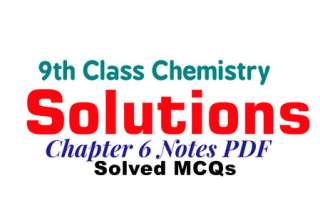In this post, I am sharing Fsc 1st Year Chemistry Chapter 10 Long Question PDF Notes for the students of FSC Part 1. Name of 11th Chemistry Chapter 10 is Electrochemistry. So the students can download Electrochemistry Chapter Long Questions notes in PDF format from here. This file contains 29 pages. These Chemistry Notes are for all the boards working under Punjab Board like Gujranwala Board, Lahore Board, Faisalabad Board, Multan Board, Rawalpindi Board, Sargodha Board, DG Kahn Board, and Sahiwal Board. Here are complete 1st Year Chemistry Notes.
11th Class Chemistry Chapter 10 “Electrochemistry” Long Question download PDF
ELECTROCHEMISTRY
Electrochemistry is the branch of chemistry, which is concerned with the conversion of electrical energy in electrolytic cell as well as the conversion of chemical energy into electrical energy in galvanic or voltaic cells.
REDOX REACTIONS;
“Those chemical reactions in which oxidation and reduction takes place simultaneously are called as redox reactions.”
Or
“Those chemical reactions which involve the gain and loss of electrons are called as redox reaction”
There are two types of redox reaction I.e. reaction taking place in a acidic medium and reactions taking place in the basic medium.
Electric current;
The flow of electrons from higher potential (higher electron density) to a region of lower potential (lesser electron density) is called as electric current.
Conductor;
“The substance through which electrical current can pass through is called as conductor.”
Or
“The substance, which can conduct electric current, is called as conductor.”
Electric conduction;
“The phenomenon of passing electric current through a conductor is called as electric conduction.” electricity can be conduct in two different ways
- Metallic conduction or electronic conduction
- Ionization
ELECTROLYTIC CELLS.
“An electrolytic cell is an electrochemical cell in which electric current is used to drive a non- spontaneous redox reaction.”
Example; Down’s cell, Nelson’s cell, etc.
Explanation; an electrolytic cell consist of following two parts,
- A vessel containing an electrolyte in its fused or dissolved state. The electrolyte is consisted of a positive and negative ions which are free to move in the solution
- Two electrodes dipped inside the electrolyte, connected with the terminals of the battery

Voltaic or Galvanic cells;
“A voltaic or galvanic cell is an electrochemical cell in which a spontaneous redox reaction is used to generate electric current.”
Example; Daniel cell, fuel cell, lead accumulator etc.
Instrumentations;
A voltaic or galvanic cell consist of two half-cells that are electrically connected. Each half cell is a portion of the the total cell in which a half reaction take place.

The Electrochemical Series;
When elements are arranged in the order of their standard, electrode potentials on the hydrogen scale, the resulting list is known as electrochemical series.

Relevant Notes
- 11th Chemistry Chapter 1 Long Questions Notes PDF
- 1st Year Chapter 2 Long Questions Notes PDF
- 11th Chemistry Chapter 3 Long Questions Notes PDF
- 1st Year Chemistry Chapter 4 Long Questions Notes
- 11th Chemistry Chapter 5 Long Questions Notes PDF
- FSC 1st Year Chemistry Chapter 6 Long Questions Notes PDF
- FSC 1st Year Chemistry Chapter 7 Long Questions Notes PDF
- 11th Chemistry Chapter 8 Long Questions Notes PDF
- 1st Year Chemistry Chapter 9 Long Questions Notes





